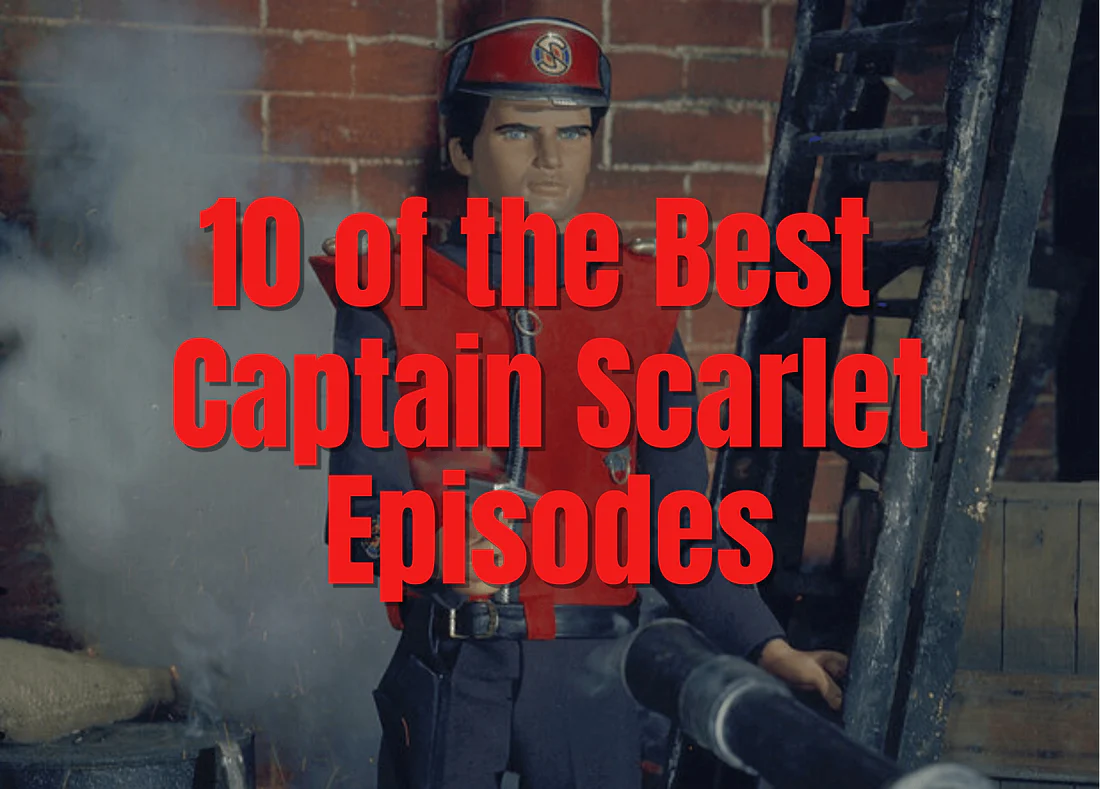10 of the Best Captain Scarlet Episodes

Captain Scarlet and the Mysterons is coming to Talking Pictures TV this weekend! Gerry and Sylvia Anderson's classic Supermarionation series begins on the 1st of June at 3 PM, taking over the afternoon weekend slot from Stingray. Captain Scarlet, as it's often shortened to, remains a significant turning point for Century 21 Productions' body of work throughout the 1960s.
Captain Scarlet tells the saga of global security organisation's Spectrum accidental war between themselves and the malevolent Mysterons, aliens situated on Mars who possess the power of retrometabolism. After capturing Spectrum agent Captain Scarlet early on in the series and murderously converting him into a Mysteron doppelganger, he eventually breaks free of his stranglehold, but retains the Mysterons' powers of indestructibility. Captain Scarlet becomes Spectrum's top agent in the outfit's fight against the Mysterons.
From this series onwards, the Andersons' much-loved marionettes would now be perfectly proportioned to look as realistic as possible, a huge leap from the more caricatured look of earlier shows. Captain Scarlet also featured a much darker atmosphere and had a greater emphasis on serialised storytelling.
As Captain Scarlet's TPTV debut draws closer, we're counting down 10 of our favourite episodes of the series!
Noose of Ice

A thrillingly unpredictable aspect of Captain Scarlet is never quite knowing where the Mysterons will strike next. There are no set rules for what or who the Mysterons may target, other than whatever they set their non-existent eyes on is sure to cause chaos and unravel some aspect of the world of 2068. Noose of Ice then stands as one of the Mysterons' most ambitious threats - to prevent Earth forces from venturing back to Mars.
This underrated gem from near the series' end conjures up some wildly macabre imagery with its gruesome title. The Hotspot mining complex at the North Pole becomes targeted for destruction, as it excavates the only known source of a powerful material to be used to enhance a new space fleet, with the mission of returning to Mars. Captain Scarlet and Captain Blue's race against time to stop the Mysteronised maintenance man Neilson cutting off the tower's power, causing the whole complex to freeze, gives way to a classically nail-biting climax. The episode's exemplary model work and special effects, with its moody arctic setting, elevates Noose of Ice into a exciting techno-disaster thriller for Captain Scarlet.
Special Assignment

Another winningly engrossing aspect of Captain Scarlet is witnessing how Spectrum and the Mysterons frequently think up new ways to deceive each other. Whilst it often falls to the Mysterons to keep Spectrum guessing, Special Assignment stands as an ambitious example of how far Spectrum is willing to go to lull the Mysterons into a false sense of security. In Special Assignment, the unthinkable happens - Captain Scarlet is forcibly resigned from Spectrum after an unforeseen gambling habit is exposed! Untethered from Spectrum, Scarlet shocks us further by seemingly allying himself with the Mysterons in their attack in Nuclear City. However, all is not as it appears, as Spectrum succeed in being several steps ahead of the Mysterons.
Scarlet's apparent abandonment of Spectrum may all be an elaborate ruse, but there's a noir-ish imagery in seeing Captain Scarlet, now just plain old Paul Metcalfe, reduced to being a lone wolf, skulking around dive bars and even betraying his closest friend, Captain Blue. It's an episode which highlights how the Mysterons' apparent omniscience can still be exploited to Spectrum's advantage. This and Dangerous Rendezvous are also the closest episodes in which Captain Scarlet and Captain Black come to face to face. A delightfully subversive entry in the series.
Attack on Cloudbase

Is there any episode in Captain Scarlet's canon more frustrating than this one? That such an appropriately doom-laden episode should transpire to be nothing more than a heat-induced nightmare experienced by Symphony Angel is understandably anticlimactic. However, Attack on Cloudbase still carries a horrifically unnerving energy to it. The episode is almost entirely without an actual story - it's a barrage of death and destruction as the Mysterons inexplicably at long last arrive on Earth themselves and proceed to destroy Cloudbase. In suitably drawn-out fashion, there's no one-strike assault against the Spectrum base. Instead, each and every member of Spectrum is picked off, one by one.
It's all exquisitely produced and paced without tripping over itself. The horror of seeing these characters whom we've come to enjoy across the series' run being killed one by one is too engrossing to turn away from. In this elaborate game of chess between Spectrum and the Mysterons, Spectrum is finally being taken down, piece by piece. Even within the safe confines of it all being a dream, Attack on Cloudbase is a daring episode that envisions the most apocalyptic scenario the war of nerves could take.
Operation Time

After the riotous action of other earlier episodes such as Winged Assassin and Point 783, this early series offering tones down the hardware in favour of a quietly tense character-driven episode, throwing forward to the more character-focused attitudes of Joe 90. Operation Time sees the Mysterons enhance their war-mongering tactics by switching to more cryptic threats issued against Spectrum with their threat to "kill time". The Mysteronised Dr Magnus is a memorable guest character, offering us an intriguing insight into how temperamental Mysteron agents can become!
Operation Time remains a pivotal moment in the war of nerves when two key weaknesses in the Mysterons are inadvertently discovered by Spectrum - they are impervious to x-rays and high voltage electricity can kill them. Both of these would come into play in the follow-up episode Spectrum Strikes Back, but Operation Time is the stronger of the pair, offering us a sort of sci-fi medical drama-thriller.
White as Snow

Another early series effort which forgoes the hardware in favour of its characters, White as Snow offers us a rare insight into some internal strife within Spectrum's own ranks. The Mysterons turn their attentions to Spectrum's commanding officer, Colonel White, who vacates Cloudbase to an undisclosed location to protect the outfit from harm. The episode brings unprecedent levels of drama via Colonel White and Captain Scarlet's clashing morals in stopping a runaway TVR 17 satellite from colliding with Cloudbase early on in the episode, initially unknown if it really is a Mysteron attack.
That drama is balanced with such amusing instances as Captain Blue embracing his temporary role as Spectrum's new commander with annoying gusto, whilst the episode itself ends on the black comedy of Colonel White sentencing Scarlet to death for his intrusive actions which wind up saving the colonel's life against the Mysterons. We would rarely see this kind of internal conflict within Spectrum again, especially coupled with such strong humour, making White as Snow all the more engaging.
Avalanche

This deceptively uncomplicated adventure may first appear pretty straight-forward, but it builds on its momentum to stirring effect. When the Mysterons threaten to destroy several links in the Frost Line Outer Space defence system, Captain Scarlet and Lieutenant Green are sent to investigate as, one by one, several of Frost Line's bases are put out of action in worryingly strange ways. The episode carries a wintry, isolated atmosphere with its snowy Canadian setting and method of attack from the Mysteronised maintenance trick driver Eddie - liquid oxygen. The episode gradually builds on its pacing as Scarlet and Green's pursuit of Eddie and his deadly maintenance truck shift's gears into an avalanche-inducing showdown.
Lieutenant Green gets a rare inclusion in the action away from Colonel White's side and brings a reassuring presence to the episode. The electronics expert proves he's more than capable in a combat situation against both the Mysterons and Frost Line's guards, who may be unaware of his knock-out abilities! Elsewhere, the trigger-happy actions of Frost Line commander General Ward generates a simmering additional layer of tension into the proceedings, as well as highlighting Captain Scarlet's anti-war morals. A riveting entry in the series, written by none other than Scott Tracy himself, Shane Rimmer. Outside of acting, Rimmer was also an established writer, penning several episodes of the later-era Supermarionation shows.
Lunarville 7

The first instalment of the Lunarville 7 trilogy highlights Captain Scarlet's ambitious stance in pushing more multi-part stories into Supermarionation. Oddly enough, the three episodes that comprise this arc aren't easily identified as an arc itself, known only by their seemingly unconnected episode titles. Lunarville 7 prizes open Captain Scarlet's world-building tactics with its rare excursion into the stars and establishing that mankind has an active lunar colonising programme - which falls victim to the Mysterons.
The revelation that the Mysterons have infiltrated Lunarville 7 and are building their own Mysteron Complex on the far side of the moon is an enthralling twist, which in turn highlights Lunarville 7's most winning aspect - its sense of terror-stricken mystery. How and when did the Mysterons begin building their own cities on the moon? When did the Lunar Controller and his aide become Mysteron agents? We may be left without answers, but isn't it more suitably terrifying that we don't know? That sense of mystery is balanced out by David Healy's scene-stealing performance as the Mysteronised Lunar Controller, who's descent into insanity provides the episode with a memorable finale.
The Heart of New York

Rippling throughout Captain Scarlet is the inescapable sense that the Mysterons' war against the Earth isn't entirely unjustified. Captain Black's accidental yet fateful destruction of the Mysterons' Martian city may have been the trigger, but episodes like The Heart of New York show the Mysterons passing judgement on humanity's seedier, less positive aspects. This moralistic fable comes off as a warning of how mankind's greed and villainy will be its ultimate downfall, and does so with effective aplomb.
In The Heart of New York, a break-in at Spectrum Security Vaults by a trio of crooks results in them staging an elaborate plan to disguise themselves as Mysteron agents in an effort to rob the Second National Bank, aka, the heart of New York, which the Mysterons have declared to be their latest target. As such, the episode's focus isn't strictly on Spectrum or the Mysterons' efforts, but rather, the three criminals, who's efforts to subvert the war of nerves for their own selfish ends ensures their deadly fate. An oddly low-key episode in which the Mysterons emerge victorious.
Shadow of Fear

There's clearly a running theme here of how arctic/snow-laden settings provide the best episodes! Shadow of Fear packs in an abundance of superb elements. Spectrum's collaboration with the K14 Observatory in capturing close-up images of Mars is seemingly hampered early on by the Mysterons, but this is all part of Spectrum's plan. Sending a decoy satellite to trick the Mysterons shows how Spectrum constantly learn throughout the war of nerves and it initially appear as though they've managed to scupper the Mysterons. Unfortunately, there's little that slips past the Martian menace, and the episode's sombre finale sees the total destruction of the K14 Observatory, gifting the Mysterons with one of their most aggressive victories.
Paul Maxwell exceeds in his role as the Mysteronised astronomy Doctor Breck. This was his last performance as part of Captain Scarlet's guest cast, which perhaps was a factor in his strong involvement in this episode. The episode's near-final shot of the Mini-Sat 5, having successfully landed on the Mars moon Phobos, transmitting its images to the destroyed K14 Observatory is downright haunting. The images have been successfully captured, but there's no-one left to receive them. Truly bleak stuff.
The Mysterons

There's an argument to be made that much of Captain Scarlet is spent trying to match the intensely thrilling sci-fi horror momentum of its first episode. The Mysterons remains one of Gerry and Sylvia's best-realised scripts, in that it crafts a hugely engaging story out of the series' core premise. Unlike many other Anderson series, you *have* to watch Captain Scarlet from the very beginning to understand the context of the war of nerves.
Spectrum's accidental triggering of the war of nerves into life against the newly discovered Mysterons sets a destructive chain of events into motion. The Mysterons utilise their ability to reverse matter to murder and then replicate Spectrum agents Captain Black, Captain Brown and Captain Scarlet to serve under them in their attack against the World President. With its fantastic fleet of futuristic action vehicles and other colour-coded heroes, Spectrum scrambles into action to counter this terrifyingly unknown threat in its first ever mission. These events culminate in Captain Scarlet eventually breaking free of his Mysteron control, but retaining the aliens' indestructible powers and becoming Spectrum's number one agent in the organisation's newfound interplanetary war.
The Mysterons is an exhilarating, brilliantly directed and alarmingly explicit sci-fi action thriller that sheds the optimism of Thunderbirds and the fantasy of Stingray. We are in defiantly darker and more violent territory with Captain Scarlet. The series' technological advances of the Supermarionation art form and its invigorating confidence in how conceptually dark and narratively elaborate its premise is offers us a definitive entry in Gerry Anderson's body of work.
To be the first to hear about the latest news, exclusive releases and show announcements, sign up to the Anderson Entertainment newsletter!




![Thunderbirds Comic Anthology Volume One [HARDCOVER] - The Gerry Anderson Store](http://gerryanderson.com/cdn/shop/files/thunderbirds-comic-anthology-volume-one-hardcover-8030771.jpg?v=1751089031&width=720)
![All Sections Alpha: The Making of Space: 1999 [HARDCOVER] - The Gerry Anderson Store](http://gerryanderson.com/cdn/shop/files/all-sections-alpha-the-making-of-space-1999-hardcover-7498116.png?v=1757766647&width=720)

![Stingray Comic Anthology Volume Two – Battle Lines [HARDCOVER] - The Gerry Anderson Store](http://gerryanderson.com/cdn/shop/files/stingray-comic-anthology-volume-two-battle-lines-hardcover-107681.jpg?v=1738856151&width=720)
![Stingray W.A.S.P. Technical Operations Manual Standard Edition [HARDCOVER] - The Gerry Anderson Store](http://gerryanderson.com/cdn/shop/files/stingray-wasp-technical-operations-manual-standard-edition-hardcover-112278.jpg?v=1749664163&width=720)
![Stingray WASP Technical Operations Manual Special Limited Edition [HARDCOVER BOOK] - The Gerry Anderson Store](http://gerryanderson.com/cdn/shop/files/stingray-wasp-technical-operations-manual-special-limited-edition-hardcover-book-991914.jpg?v=1749657538&width=720)
![Stingray: The Titanican Stratagem – Signed Limited Edition [HARDCOVER NOVEL] - The Gerry Anderson Store](http://gerryanderson.com/cdn/shop/files/stingray-the-titanican-stratagem-signed-limited-edition-hardcover-novel-129251.jpg?v=1740558711&width=720)







